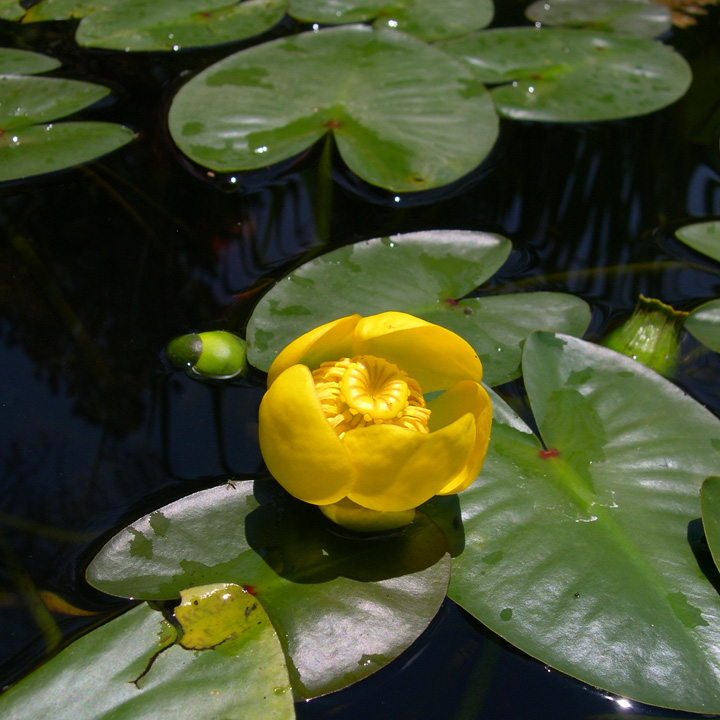
|
Family: Nymphaeaceae |
Rhizomes branched, repent; stolons absent. Leaves floating, submersed, or emersed. Leaf blade orbiculate to linear, basal lobes divergent to overlapping, margins entire, apex of lobe narrowly obtuse to broadly rounded; primary venation mostly pinnate, basal section of midrib with several parallel veins. Flowers floating or held above surface of water, opening diurnally; perianth hypogynous, not spreading, nearly globose at anthesis; sepals 5-9(-12), outwardly yellow to green, becoming yellow within, often red-tinged, oblong or obovate to somewhat orbiculate; petals numerous, spirally arranged, inconspicuous, stamenlike; stamens yellow- or red-tinged, inserted below ovary, recurved at dehiscence, distal connective appendage absent; ovary longer than petals and stamens; stigmatic disk with margin entire to crenate or dentate, appendages absent. Fruits borne on straight peduncles. Seeds ovoid, to 6 mm; aril absent. x = 17. The taxonomy of the genus is problematic. E. O. Beal (1956) departed dramatically from previous North American treatments in recognizing a single polymorphic species, Nuphar lutea (name of European origin), with several subspecies formerly treated as species. Subsequent research (C. E. DePoe and E. O. Beal 1969; E. O. Beal and R. M. Southall 1977) has supported Beal's treatment for some southeastern subspecies, but most other taxa have not been studied as extensively. Beal's treatment, for the most part, has not been adopted in the Northeast and elsewhere in North America or in Europe. Molecular studies of Nuphar currently in progress (D. J. Padgett, pers. comm.) have clearly shown the North American taxa to be distinct from the Eurasian Nuphar lutea ; Beal's nomenclature under that taxon cannot be upheld. Continuing to treat those taxa at subspecific rank would require new combinations under Nuphar sagittifolia (Walter) Pursh, the oldest name that has hitherto been applied only in a geographically restricted sense. Until the molecular studies are completed, creating new names is premature. We therefore return to the previous treatment of the taxa as species. Prior to conservation in its current sense, the name Nymphaea was frequently used for Nuphar . Although often treated as neuter, Nuphar was originally assigned the feminine gender (W. T. Stearn 1956; H. W. Rickett and F. A. Stafleu 1959). The name Nymphozanthus Richard has been rejected.
STEMS: of branching rhizomes. LEAVES: lanceolate to orbicular, deeply cleft, entire, pinnately veined, glabrous above and glabrous to densely pubescent below; petiole terete, flattened or winged, glabrous to pubescent. FLOWERS: usually floating; sepals 5-14, greenish, yellow- or red-tinged, persistent; petals numerous, inconspicuous, scale- or stamen-like, oblong to spatulate, often emarginate; stamens numerous, yellow- or red-tinged; pistils with 5-many, mostly united carpels; stigmatic disk broad, concave or flat, with 5-many rays; ovary multi-locular, each locule with numerous ovules. FRUIT: a leathery berry, ovoid to columnar, usually ripening above the water surface. SEEDS: narrowly to broadly ovoid, yellow to brown, with a more or less conspicuous raphe. X = 17. NOTES: 1-3 sp., mostly temperate, subartie to subtropical areas of the n hemisphere. (From the Arabic name, Naufar, for some unknown waterlily). Taxonomically difficult and not well understood. Beal, E. O. 1956. J. Elisha Mitchell Sci. Soc. 72:317-346. REFERENCES: Ricketson, Jon. 1995. Nymphaeaceae. J. Ariz. - Nev. Acad. Sci. 29(1). 26. Sep mostly 6, sometimes only 5, concave, imbricate, petaloid, forming a subglobose or deeply saucer-shaped yellow fl; pet many, much smaller than the sep, usually shorter than the numerous, hypogynous stamens; stigmatic disk with 6-24 radiating lines; lf-blades basally cordate to hastate; petioles and peduncles with numerous minute air- cavities; 2n=34. (Nymphaea of auth., misapplied) 15, N. Temp. and cold. Gleason, Henry A. & Cronquist, Arthur J. 1991. Manual of vascular plants of northeastern United States and adjacent Canada. lxxv + 910 pp. ©The New York Botanical Garden. All rights reserved. Used by permission. |
This project was made possible in part by the Institute of Museum and Library Services [MG-70-19-0057-19].
Powered by Symbiota



